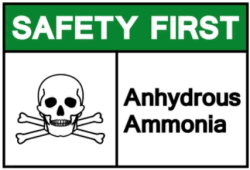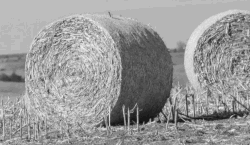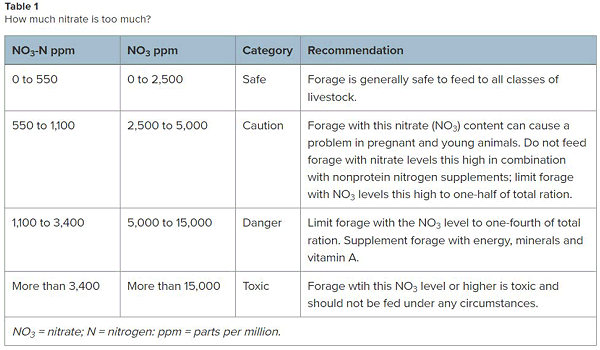

To send a message to an author, click on the author's name at the end of the article.
This Month in Ag Connection | Ag Connection - Other Issues Online
Anhydrous ammonia is an effective and efficient way to supply nitrogen fertilizer to field crops. Autumn application after harvest can lighten some of the spring workload so planting can begin as soon as field conditions allow. However, fall applied nitrogen is at risk of being lost due to leaching or volatilization.
Microbes are active when soil temperatures are above 40 degrees Fahrenheit. They convert the stable ammonium to nitrate, which can leach through the soil profile when soils become saturated. Anhydrous ammonia should not be applied until soil temperatures at the six-inch depth are below 50 degrees Fahrenheit and a nitrification inhibitor should be used to reduce losses. Waiting until soil temperatures reach 40 degrees Fahrenheit is recommended. Volatilization occurs when anhydrous ammonia is exposed to air. The key to reducing volatilization is to ensure injection slots are fully closed.
Because anhydrous ammonia is attracted to water, it will quickly combine with the water in any body tissue. Injury occurs when a victim cannot escape an accidental, sudden release of anhydrous ammonia which can cause chemical burns or frostbite to skin, eyes, or the respiratory tract. It is important to take time to follow the recommended safety precautions when applying anhydrous ammonia fertilizer.

Minimum personal protective gear for handling anhydrous ammonia includes goggles or a face shield, rubber gloves and a heavy long-sleeved shirt. Protecting the face and particularly the eyes is critical. It has a strong affinity for water and evaporates rapidly creating a freeze-drying effect when it contacts skin or eyes. Wear properly fitted goggles or a face shield to avoid direct exposure from an accidental release of ammonia. Prescription glasses or sunglasses do not provide adequate protection. Never wear contact lenses. The contact lenses can trap the gas between the lens and the eye causing permanent damage. A face shield is a good choice because it will not only protect the eyes, but also protects against inhalation of the ammonia. Loose fitting rubber gloves with an extended cuff are the preferred gear to protect hands. Turn down the cuff to catch any ammonia that escapes so it does not run into shirts sleeves when arms are raised. A heavy long sleeve work shirt and/or coveralls will protect skin.
Time is critical if an accidental exposure occurs because injury can occur quickly. Move the victim to a safe place and immediately flush the contaminated area for 15 minutes with clean water. Remove contaminated clothing. Clothing may be frozen to the victim's skin, making it necessary to thaw it with water before removing. Keep a six-to-eight-ounce eye wash bottle available to immediately flush eyes. A minimum of five gallons of fresh, clean water should be kept in the tractor being used for application. Do not apply salves or ointments to exposed skin and seek medical treatment immediately. If a victim swallows anhydrous ammonia have them drink large amounts of water to dilute the chemical.
Inspect all tanks and equipment daily for signs of damage or wear. Remove any dirt or other debris on couplers and check threads for damage before making the connection. Work upwind of tanks and valves, and in an open area which will allow for a quick escape if necessary.
For more information, refer to MU Guide 1920 Using Agricultural Anhydrous Ammonia Safely https://extension.missouri.edu/publications/g1920.
Source: Valerie Tate, Agronomy Specialist
This Month in Ag Connection | Ag Connection - Other Issues Online
The spring grass hay crop was extremely poor across many regions of Missouri. Beef cattle producers are turning to alternative feeds to find winter forage for their herds. Baled corn stalks are one of the more available forage sources for many producers. A discussion of baled corn stalks quality and use follows.

Baled corn stalks are a completely different feedstuff than grazed corn stalks. Baled stalks do not offer the opportunity for cattle to glean grain from fields, and therefore a lot of the feed value of corn stalks is lost. They will be lower in quality and can potentially have a large amount of waste since the stalk is baled up along with the more nutritional leaves and husks.
During 2018, regional livestock specialists received several forage test results for baled corn stalks. There was a wide range of nutritional value. Crude protein ranged from 2.6% to 6.0% and total digestible nutrients (TDN, an estimate of energy value) ranged from 31.6% to 45.0%. How will this quality of forage affect winter feeding programs for beef cows?
First, realize intake of baled corn stalks will be low, with some estimates being 1.2% of body weight on a dry matter basis. The expected intake of hay less than 52% TDN, is 1.8% of body weight. So right off the bat, there is an issue with total feed intake.
Using an expected intake of 15 pounds of dry matter combined with average protein and energy values from the 2018 corn stalk bale results, a dry, second period cow would consume 72% of expected dry matter intake, receive 48% of her energy requirement and 33% of her protein requirement if only being fed corn stalk bales.
Obviously additional energy and protein are needed for this animal, especially as she gets closer to calving time. For this second period cow, a supplement mix of 4.0 pounds of corn, 1.5 pounds of dry distiller's grain, and 0.5 pounds of soybean meal, or an equivalent mix, is needed to meet energy and protein needs when fed at a rate of 6.0 pounds per head per day. Additional mineral supplementation is also needed to meet nutritional requirements for this animal.
Supplying only protein in the form of lick tubs, protein blocks, etc. will not provide enough energy to meet the nutritional needs of the animal and poor performance, including weight loss, can be expected from this scenario.
Due to the variability in nutritional content and potential nitrate issues, it is strongly recommended producers submit forage samples for nutrient analysis. Forage analysis identifies the nutrients needing to be added to the diet which prevents feeding the wrong nutrients or the wrong amount of a particular nutrient. Nutritionally inappropriate diets will be very expensive this year due to the cost of various feedstuffs and the length of time conserved feeds will be fed.
Baled corn stalks certainly have a place in winter feeding programs this year. However, they may be best considered as a way to stretch hay supplies rather than to be the hay supply. Be aware that a high level of waste will probably occur, and adjust feed amounts accordingly.
If you have questions or need assistance with collecting forage samples, interpreting forage sample results, or developing winter feeding programs, contact your local extension office and they can connect you with the regional extension livestock specialist.
Source: Gene Schmitz, Livestock Specialist
This Month in Ag Connection | Ag Connection - Other Issues Online
In 2023, drought conditions reduced cool-season hay yields by half or more in Northeastern Missouri. As a result, many farmers planted warm season annual forages, such as Sudangrass, sorghum-Sudangrass or "Sudex" and pearl millet. These warm season annuals come with unique challenges, particularly in managing nitrate accumulation and, except for pearl millet, also high levels of prussic acid (cyanide). In addition to these three warm season grasses, which are grown intentionally, another significant concern is johnsongrass, a common weed in Missouri fields, which, like Sudangrass and "Sudex," is a Sorghum species known for its high levels of both nitrates and prussic acid and is associated with cattle deaths during the summer growing season. This article explores these toxicological concerns in detail, focusing on stockpiled, ensiled, or baled warm season annuals from the sorghum and millet families, as well as, potentially, johnsongrass.
When farmers make hay from these warm season annuals, the process fixes the nitrate concentration within the bale. However, prussic acid dissipates during the normal hay curing process. Ensiling these forages is a beneficial process as it can reduce nitrate concentrations by 25-50% and aid in lowering prussic acid levels in the forage. It is advisable to let hay bales sit for an additional two weeks after baling to ensure a significant reduction in prussic acid concentration. Damp or wet hay suspected of being high in nitrate should not be fed to cattle, because, like what occurs in piles of green chop corn and inside the cattle's rumen, nitrate accumulated in the plant can potentially be converted to more toxic nitrite in hay with a high moisture content. Fed cattle should be introduced gradually to high nitrate forages. In addition, to ensure safer digestion, farmers should feed a high energy commodity along with high nitrate feeds, ideally just before the cattle have access the high nitrate portion of their ration.
Ensiling should ideally extend over a minimum of 30 days before taking samples for quantitative nitrate analysis. To minimize prussic acid concentrations and maximize dry matter yield, farmers should cut these plants when they are at least three feet tall. Cutting these plants when they are shorter than two feet tall increases the risk of prussic acid (cyanide) poisoning. Plant regrowth can be affected when plants are cut less than eight inches from the ground. Also, higher nitrate concentrations are possible when mowing low. Before cutting any warm season annual forages or even stands of johnsongrass growing in a pasture, conducting a field nitrate test can guide the cutting height, especially since nitrates typically accumulate in the lower portion of the plant's stem.
If a field test indicates high nitrate levels, a quantitative nitrate test at a qualified laboratory is advisable before cutting. After significant rainfall, particularly during dry periods, nitrates can spike within the plant, and farmers should wait at least seven to ten days after a rain to cut or allow grazing of these forages. Also, field tests have shown that, under some circumstances during drought conditions, high nitrate concentrations can occur throughout the length of the plant's stalk, even in plants which are three to four feet tall.
The application of herbicides like 2,4-D can also lead to spikes in nitrate concentrations in these forages. Hence, it's critical to test all warm season annual forages for both feed value and quantitative nitrate levels before they are taken to livestock in the winter. Rations can be adjusted based on these values, using resources like the MU Guide G9800 and consulting with a local extension livestock specialist. It is important to pay attention to laboratory results and whether they are reported as concentrations of nitrate or nitrate-nitrogen. For instance, forages containing 3,400 ppm or 0.34% of nitrate on a dry-matter basis would be expected to be relatively safe to feed, especially to nonpregnant animals. Conversely, forages containing 3,400 ppm or 0.34% of nitrate-nitrogen could potentially be lethal (see chart next).

Prussic acid typically accumulates in the leaves of these plants. Therefore, new growth/regrowth after a frost, drought, hail, or herbicide application is extremely likely to experience an increase in prussic acid concentration. It is recommended that members of the Sorghum family should not be grazed before they reach a height of at least twenty-four inches (two feet). Following a drought or summer regrowth, a waiting period of two weeks is suggested to allow prussic acid levels to dissipate before grazing stockpiled warm season annual grasses. If freezing conditions are anticipated, cattle should be immediately removed from pastures containing these forages. In cases where plants are cold stressed and frost damaged, but not killed, it is advisable to wait for at least two weeks before cutting or grazing these forages. Once there is a hard or killing frost with no regrowth, there should be at least a seven-day waiting period before any animal exposure to these plants. Warm season annuals will not have the best forage quality typically once you are outside of the growing season but can be utilized. Protein is often the first limiting nutrient in low-quality warm season forages. Aim to provide between 0.5 and 1.0 pounds of crude protein per cow per day to overcome the deficit.
It is worth remembering that quantitative nitrate and nitrate-nitrogen concentrations are routinely reported on a dry-matter basis. While reporting these concentrations on a dry-matter basis is ideal for hay, the potential risk for nitrate/nitrite poisoning is overestimated for these forages when they are high in moisture, growing in the field. Consult with extension livestock and agronomy specialists and their local veterinarian, should assist farmers in making the best decisions for their cattle operation, taking into consideration predicted weather conditions and the feedstuffs available to them, as well as the nutritional needs and well-being of their cattle.
Source: Nick Wesslak, Agronomy Specialist

Publishing Information
Ag Connection is published monthly for Northeast and Central areas of Missouri producers and is supported by the University of Missouri Extension, the Missouri Agricultural Experiment Station, and the MU College of Agriculture, Food and Natural Resources. Managing Editor: Mary Sobba.